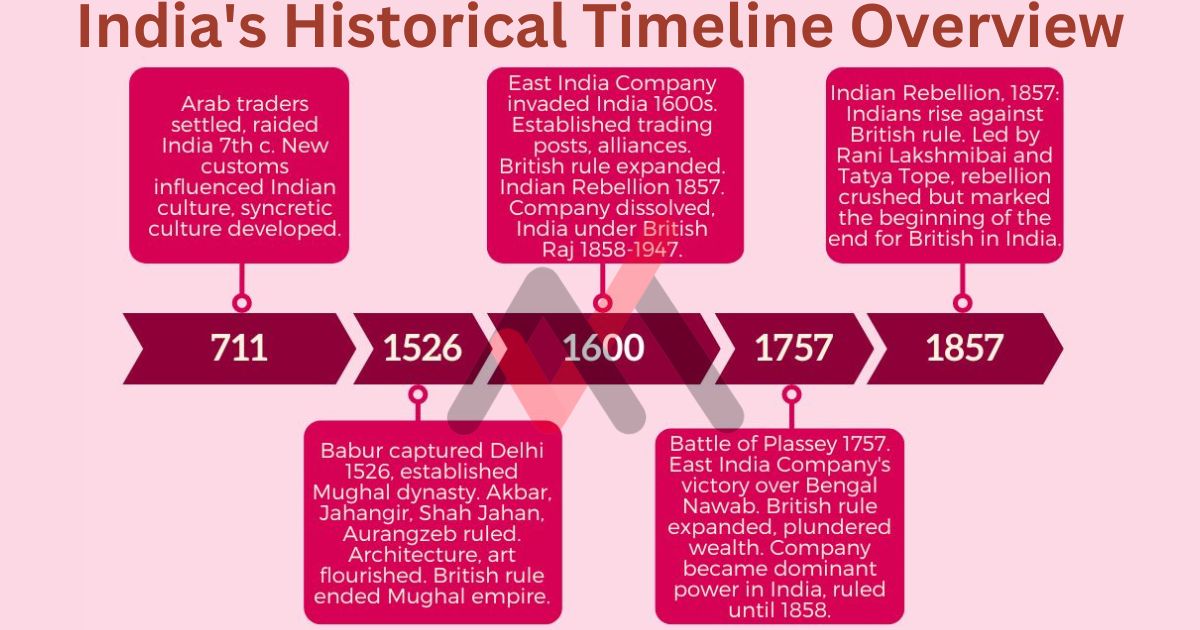India has a rich and diverse history that spans thousands of years. From the ancient Indus Valley Civilization to the British rule in India or the British Raj, India has seen a myriad of different rulers and influences over the years. However, two of the most significant periods in India’s history were the Arab invasion and the current Modi era.
Page Index
The Arab Invasion
The Arab invasion of India began in the early 7th century AD when Arab traders began to visit the Indian subcontinent. Over time, these traders began to settle in the region, and by the 8th century, they had established a number of small states along the western coast of India.
These Arab states were known for their trading prowess and their ability to control the lucrative trade routes between India and the Middle East. However, the Arab invasion of India truly began in the 10th century when Mahmud of Ghazni, a Muslim ruler from Afghanistan, invaded northern India.
Mahmud’s raids were primarily aimed at plundering the rich temples and cities of northern India, and he carried out numerous raids over the course of his reign. The Arab invasion of India had a significant impact on Indian society and culture.
The influx of Arab traders and settlers brought with it new customs, beliefs, and practices that began to meld with the existing Indian culture. This led to the development of a new syncretic culture that was a blend of Indian and Arab influences.
Timeline Story
Arab Invasion
The Arab invasion of Sindh marks the beginning of the Islamic period in India. The invasion was led by Muhammad bin Qasim, who defeated the Hindu ruler of Sindh and established the first Muslim state in India. This period saw the rise of several powerful Islamic dynasties, including the Delhi Sultanate and the Mughal Empire.
Mughal Empire
Babar establishes the Mughal Empire in India, which becomes one of the most prosperous and powerful empires in the world. Under the Mughals, India experienced a period of relative stability and prosperity, with advances in art, architecture, and literature. However, the decline of the Mughal Empire in the 18th century paved the way for British colonization.
East India Company
The British East India Company is established, marking the beginning of British involvement in India. The company was granted a royal charter by Queen Elizabeth I, giving it a monopoly on English trade with Asia. The company soon established trading posts in India and began to expand its influence over the subcontinent.
Battle of Plassey
The British East India Company defeats the Nawab of Bengal at the Battle of Plassey, consolidating their control over India. The battle marked the beginning of British colonial rule in India, with the company effectively acting as a government in its own right. The company’s rule was characterized by economic exploitation, social disruption, and political oppression.
Indian Rebellion
The Indian Rebellion against British rule takes place, resulting in the end of the East India Company and the beginning of direct British rule over India. The rebellion, also known as the Sepoy Mutiny, was triggered by a number of factors, including economic exploitation, cultural imperialism, and religious intolerance. The rebellion was ultimately suppressed by the British, but it marked a turning point in India’s struggle for independence.
Indian Independence
India gains independence from British rule and becomes a republic. The independence movement was led by figures such as Mohandas Gandhi and Jawaharlal Nehru, who fought for India’s freedom through non-violent means. The movement succeeded in achieving independence in 1947, but it was also marked by the partition of India and the creation of Pakistan, leading to a period of India gains independence from British rule and becomes a republic.
Emergency
Indira Gandhi declares a state of emergency, suspending civil liberties and granting herself extensive powers. The emergency lasted for 21 months and was marked by human rights abuses, including forced sterilization and torture of political opponents. The emergency ended in 1977, when Gandhi called for elections and was defeated.
Economic Liberalization
India launches a program of economic liberalization, opening up its economy to foreign investment and reducing government regulations. The liberalization program was initiated by Prime Minister Narasimha Rao and his finance minister, Manmohan Singh, and led to a period of rapid economic growth and modernization.
Modi Era
Narendra Modi becomes the Prime Minister of India, marking a new era in Indian politics. Modi’s government has focused on economic development, social reform, and national security, but has also faced criticism for its Hindu nationalist agenda and crackdowns on dissent.
The Modi Era
Fast forward to the present day, and India is now under the leadership of Prime Minister Narendra Modi. Modi’s rise to power marked a significant shift in India’s political landscape.
Prior to his election, India had been dominated by the Indian National Congress, a center-left political party that had been in power for most of India’s post-independence history.
Modi, on the other hand, is a member of the Bharatiya Janata Party (BJP), a right-wing Hindu nationalist party. His election marked a significant shift towards a more conservative, nationalist India.
Under Modi’s leadership, India has become more focused on economic growth and development and has taken a more assertive stance on foreign policy.
However, Modi’s tenure has also been marked by controversy. His government has been accused of cracking down on dissent, stifling freedom of speech, and targeting minorities, particularly Muslims.
These accusations have been met with both praise and criticism, with some seeing Modi as a strong leader who is putting India on the path to greatness, and others seeing him as a divisive figure who is eroding India’s secular fabric.
Conclusion
The Arab invasion and the Modi era represent two very different periods in India’s history. The Arab invasion brought with it new customs and practices that helped to shape Indian culture, while the Modi era marked a significant shift towards a more conservative, nationalist India.
Both periods have had a significant impact on Indian society and culture and will continue to shape the country for years to come.


